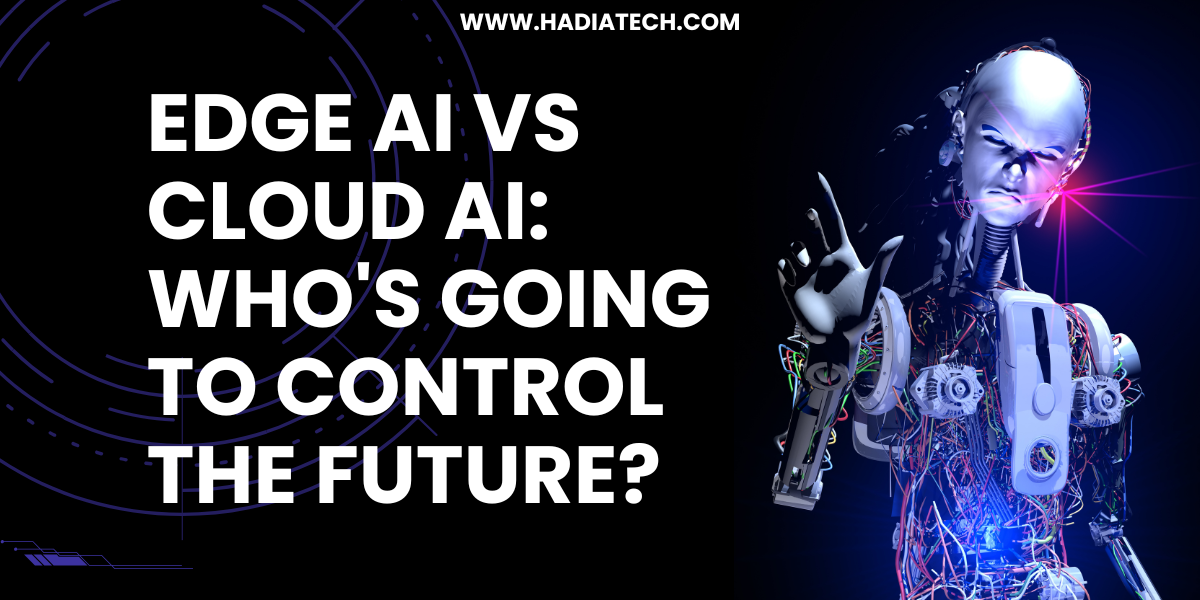Edge AI vs Cloud AI: Who’s Going to Own the Future?
I want to talk about something I’ve been giving a lot of thought to lately: Edge AI and Cloud AI. You probably know what AI (artificial intelligence, just in case you heard the phrase for the first time lately) is, but did you know they exist in different ways in terms of how they’re being applied? Some of the AI happens on your device—like how you get your phone unlocked when you look at it—and some of the AI has to happen in the cloud, like when you ask Siri to read you the weather. Will it be one of those? Edge AI, cloud AI, or both? Just make it easy, like having a cup of coffee.

What the Heck Is Edge AI?
Edge AI is having a little brain in your gadget. It’s native AI, in your gadget itself, and not on the internet. Think about this: your smartwatch is tracking your steps or that home surveillance camera is looking for faces—everything is happening natively, without streaming the data up to some far-off server. Not only quick but also personal, and it doesn’t even require Wi-Fi. Not bad, right?
But the point is, your computer only has so much processing power. It’s not infinite. So, of course, edge AI is wonderful for small things that need to be done quickly, but it’s not there to do the heavy lifting. That’s when Cloud AI comes into play.
And What About Cloud AI?
Cloud AI has a supercomputer sitting idle in the clouds. It’s powerful, can handle truckloads of data, and perfect for heavy jobs. You’ve always wondered how Netflix will be able to know what you’re watching? That’s Cloud AI going through tens of millions of bytes of data to suggest something. Or when you post a photo on Google Photos, and your friends automatically get autotagged—that’s Cloud AI going overdrive in the background.
The downside? It needs a solid internet connection, and there’s a tiny delay as data travels to the cloud and back. For most things, that’s fine, but if you’re in a self-driving car, even a split-second delay could be a problem.
The Good and the Bad of Each
Let’s keep it simple:
Edge AI:
Pros: Super fast, private (your data stays on your device), and works without internet.
Pros: None, but you can use more of them.
Cons: You’re a slave of your device’s memory and power. Can’t cope with humongous, complicated things.
Cloud AI:
Pros: Can manage gazillions of data and do complicated things.
Cons: Requires high-speed internet, and there is the teeniest of lags.
So, if you require speed and anonymity, Edge AI’s your solution. If you need intense processing, Cloud AI’s your solution.

Real-Life Examples to Make It Click
I’ll give you a couple of examples here. If you look at Face ID on your iPhone, that’s Edge AI. Your phone’s computing it all fine there locally—no data is being shipped to Apple. It’s fast and secure. But if you ask Google Assistant to translate a sentence, that’s Cloud AI. Your request is being shipped out to a server, processed there, and sent back to you with the answer.
Another comparison: Smart thermostats such as Nest use Edge AI to adapt to your schedule and adjust the temperature automatically without sending it to the cloud. But if you want to compute how much energy you use in a year, that’s probably being done in the cloud.
So, Which One’s Going to Win?
The million-dollar question here is, who is driving future AI? Seriously, I don’t believe it’s a war. Both have their points, and the future is most likely going to be a merge of both.
Edge AI is ideal for real-time applications, such as autonomous transportation or wearable device critical sign monitoring. The more intelligent our devices are (hi, Internet of Things), the more important Edge AI will be. And with everyone’s minds busy thinking about privacy these days, local data on the device is a major advantage.
Cloud AI isn’t leaving either. For things needing a tremendous amount of computational oomph—like having an AI model run or world trend watching—Cloud AI is still the way to go. And with even faster internet (like 5G), the lag issue might not be so bad in the future.
But if I must choose one that will progress at a quicker rate, I’d say Edge AI. Why? Because the moment our hardware becomes more powerful, we’ll be able to accomplish more locally on our device, without the cloud. Same reason phones used to just make phone calls but now are mini-computers.
Why Should You Care
You might be thinking, “Okay, cool, but why does this matter to me?” Well, if you’re a business owner, choosing the right AI can make or break your product. Imagine building an app that needs to respond instantly—Edge AI could be the way to go. Or if you’re working on something that needs to crunch a lot of data, Cloud AI’s your best bet.
Even if you’re not a tech enthusiast, it all affects your daily existence. Your watch, your car, even your fridge may be using Edge AI or Cloud AI to make your life easier. Understanding the difference keeps you current on why things work the way they do—and what’s around the corner.
A Hybrid Future?
Something to remember: the future won’t be Edge AI or Cloud AI; it will be both of them together. Think of a self-driving car that uses Edge AI for real-time dynamic pothole detection on the road, but Cloud AI for traffic updates or navigation. It’s having a fast-deciding co-pilot and a wise tactician together.
Mostly, they do this in practice. Your phone, for instance, would employ Edge AI for simple operations like the brightness control but Cloud AI for complicated ones such as voice recognition.
Let’s Wrap This Up
And who will prevail? If I had my money on it, I’d bet on Edge AI getting a little bit of, if you’ll pardon the pun, edge in the future. But as hardware gets smarter and humans become more privacy-oriented, the direction is to do it locally. But for brainware, Cloud AI will always be en vogue.
But when they are merged, magic occurs. The AI future isn’t war—it’s synergy. And believe me, that’s the good stuff.
Opinion? Team Edge AI, Cloud AI, or somewhere in the middle? Give me your two cents on that.





